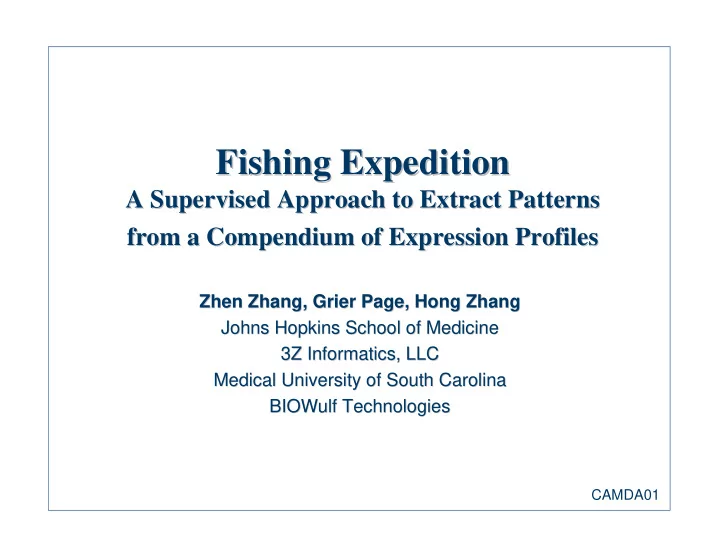

Fishing Expedition Fishing Expedition A Supervised Approach to Extract Patterns A Supervised Approach to Extract Patterns from a Compendium of Expression Profiles from a Compendium of Expression Profiles Zhen Zhang, Grier Grier Page, Hong Zhang Page, Hong Zhang Zhen Zhang, Johns Hopkins School of Medicine Johns Hopkins School of Medicine 3Z Informatics, LLC 3Z Informatics, LLC Medical University of South Carolina Medical University of South Carolina BIOWulf Technologies Technologies BIOWulf CAMDA01
Motivation Motivation Motivation • Many genes have multiple molecular functions and are involved in different biological processes; • Direct application of 2D hierarchical cluster forces a gene to cluster to one of the clusters; • May result in noisy and scattered patterns for large dataset. CAMDA01
The Idea: Fishing with “Baits” The Idea: Fishing with “Baits” The Idea: Fishing with “Baits” • Class 1 - the baits: a small number of profiles (or genes) with conditions associated with the molecular functions or biological processes of interest. • Class 2: control profiles, or the baits unselected large number of profiles. • Supervised component analysis methods to find a subset of relevant genes and profiles. • 2D hierarchical cluster analysis and view to further identify target controls genes and/or profiles. CAMDA01
Unified Maximum Separability Unified Maximum Separability Unified Maximum Separability Analysis (UMSA) Analysis (UMSA) Analysis (UMSA) • Incorporating data distribution information into the empirical risk minimization algorithm of support vector machine (SVM). • More efficient use of information from a limited number of samples. • Adjustable parameters controls the influence of distribution information. LDA SVM UMSA CAMDA01
A Little Detail of UMSA A Little Detail of UMSA A Little Detail of UMSA
UMSA Component Analysis UMSA Component Analysis UMSA Component Analysis • Find a projection vector d along which two classes of data are optimally separated for a given set of UMSA parameters. • Project the data onto a subspace perpendicular to d . • Iteratively, apply UMSA to compute a new projection vector within this subspace, until a desired number of components have been reached. CAMDA01
UMSA Component Analysis vs vs. PCA/SVD . PCA/SVD UMSA Component Analysis UMSA Component Analysis vs. PCA/SVD • Both reduce data dimension. • PCA/SDV components represent directions along which the data have maximum variations • UMSA components correspond to directions along which classes of data achieve maximum separation • PCA/SVD: unsupervised, for data representation; • UMSA component analysis: supervised, for data classification. CAMDA01
An Example: Extracting Patterns from a An Example: Extracting Patterns from a An Example: Extracting Patterns from a Compendium of Expression Profiles Compendium of Expression Profiles Compendium of Expression Profiles • Reference database of expression profiles of yeast mutants and chemical treatments*. • Experiments with ≥ 2 genes up- or down-regulated at ≥ 3 fold, and p ≤ 0.01; and genes up- or down-regulated at ≥ 3 fold, and p ≤ 0.01 in ≥ 2 experiments. • 136 profiles and 551 ORFs selected from the original data of 300 experiment profiles and 6298 ORFs • plus Profiles of 63 negative controls. * Hughes T.R. et. al. Functional Discovery via a Compendium of Expression Profiles. Cell, 102 (July 2000), 109-126. CAMDA01
An Example: UMSA Component Analysis An Example: UMSA Component Analysis An Example: UMSA Component Analysis • Class 1 (“baits”) :Mutants erg2 ∆ , and erg3 ∆ , and tet- ERG11; • Class 2: 63 negative controls. • UMSA component analysis parameter s=10.0 and K=5.0. • Results: 78 profiles and 200 genes were selected. CAMDA01
CrossView: a Software Package : a Software Package CrossView CrossView: a Software Package Implements UMSA Implements UMSA Implements UMSA CAMDA01
Selection of Genes and Profiles Selection of Genes and Profiles Selection of Genes and Profiles CAMDA01
2D Hierarchical Cluster of All Data 2D Hierarchical Cluster of All Data 2D Hierarchical Cluster of All Data CAMDA01
2D Hierarchical Cluster of Selected Data 2D Hierarchical Cluster of Selected Data 2D Hierarchical Cluster of Selected Data CAMDA01
Comparison of ORFs ORFs Identified Identified Comparison of Comparison of ORFs Identified ORFs Large Set Reduced Set YDR453C * * YER044C * * YGL001C * * SCM4/YGR049W * * ERG25/YGR060W * ERG1/YGR175C * * ERG11/YHR007C * * YJL113W * * ELO1/YJL196C * * YSR3/YKR053C * ERG3,SYR1/YLR056W * YLL012W * ERG6//YML008C * * ERG5/YMR015C * * YNL278W * YMR134W * CYB5/YNL111C * HES1/YOR237W * * YPL272C * * * ORF identified. CAMDA01
A Different Example A Different Example A Different Example Tissue Specific Tumor 4000+ genes After clustering 400 Selected Genes (Tissue Specific) after clustering
Conclusions Conclusions Conclusions • Analysis of large database requires careful balance between efficiency through data reduction and minimizing the risk of losing useful information. • Using a supervised method, known properties of experiments and genes are incorporated into the selection process to improve the effectiveness and efficiency of pattern matching and detection. • Most useful for "fishing out" unknown relationships amongst genes and profiles that have something in common with the pre-selected "bait" profiles or genes. CAMDA01
Recommend
More recommend